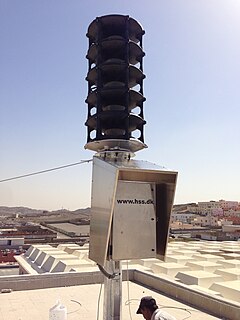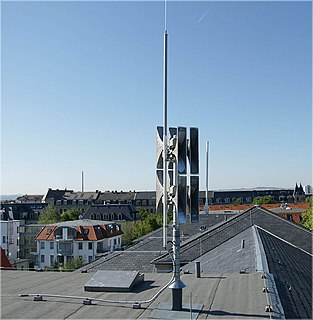Related Research Articles

Civil defence or civil protection is an effort to protect the citizens of a state from natural disasters. It uses the principles of emergency operations: prevention, mitigation, preparation, response, or emergency evacuation and recovery. Programs of this sort were initially discussed at least as early as the 1920s and were implemented in some countries during the 1930s as the threat of war and aerial bombardment grew. It became widespread after the threat of nuclear weapons was realized.

North American Aerospace Defense Command, known until March 1981 as the North American Air Defense Command, is a combined organization of the United States and Canada that provides aerospace warning, air sovereignty, and protection for Northern America. Headquarters for NORAD and the NORAD/United States Northern Command (USNORTHCOM) center are located at Peterson Space Force Base in El Paso County, near Colorado Springs, Colorado. The nearby Cheyenne Mountain Complex has the Alternate Command Center. The NORAD commander and deputy commander (CINCNORAD) are, respectively, a United States four-star general or equivalent and a Canadian three-star general or equivalent.

A civil defense siren is a siren used to provide an emergency population warning to the general population of approaching danger. It is sometimes sounded again to indicate the danger has passed. Some sirens are also used to call the volunteer fire department when needed. Initially designed to warn city dwellers of air raids in World War II, they were later used to warn of nuclear attack and natural destructive weather patterns such as tornadoes. The generalized nature of sirens led to many of them being replaced with more specific warnings, such as the broadcast-based Emergency Alert System and the Cell Broadcast-based Wireless Emergency Alerts and EU-Alert mobile technologies.

The United States Department of Homeland Security (DHS) is the U.S. federal executive department responsible for public security, roughly comparable to the interior or home ministries of other countries. Its stated missions involve anti-terrorism, border security, immigration and customs, cyber security, and disaster prevention and management.

The Federal Emergency Management Agency (FEMA) is an agency of the United States Department of Homeland Security (DHS), initially created under President Jimmy Carter by Presidential Reorganization Plan No. 3 of 1978 and implemented by two Executive Orders on April 1, 1979. The agency's primary purpose is to coordinate the response to a disaster that has occurred in the United States and that overwhelms the resources of local and state authorities. The governor of the state in which the disaster occurs must declare a state of emergency and formally request from the President that FEMA and the federal government respond to the disaster. The only exception to the state's gubernatorial declaration requirement occurs when an emergency or disaster takes place on federal property or to a federal asset—for example, the 1995 bombing of the Alfred P. Murrah Federal Building in Oklahoma City, Oklahoma, or the Space Shuttle Columbia in the 2003 return-flight disaster.

The Emergency Alert System (EAS) is a national warning system in the United States designed to allow authorized officials to coordinate and disseminate emergency alerts and warning messages to the public via terrestrial and satellite radio and television, including broadcast and multichannel television.

The Cheyenne Mountain Complex is a Space Force installation and defensive bunker located in unincorporated El Paso County, Colorado, next to the city of Colorado Springs, at the Cheyenne Mountain Space Force Station, which hosts the activities of several tenant units. Also located in Colorado Springs is Peterson Space Force Base, where the North American Aerospace Defense Command (NORAD) and United States Northern Command (USNORTHCOM) headquarters are located.

In the United States, state defense forces are military units that operate under the sole authority of a state government. State defense forces are authorized by state and federal law and are under the command of the governor of each state.

The Caribbean Disaster Emergency Management Agency (CDEMA) is an inter-regional supportive network of independent emergency units throughout the Caribbean region. Formed on September 1, 2005 as the Caribbean Disaster Emergency Response Agency (CDERA) it underwent a name change to CDEMA in September 2009.

An emergency population warning is a method whereby local, regional, or national authorities can contact members of the public en masse to warn them of an impending emergency. These warnings may be necessary for a number of reasons, including:

Emergency management is the organization and management of the resources and responsibilities for dealing with all humanitarian aspects of emergencies. The aim is to prevent and reduce the harmful effects of all hazards, including disasters.

The Ministry of the Russian Federation for Civil Defence, Emergency Situations and Elimination of Consequences of Natural Disasters, also known as the Ministry of Emergency Situations or internationally as EMERCOM, is a Russian government agency overseeing the civil emergency services in Russia.

The Military Auxiliary Radio System (MARS) is a United States Department of Defense sponsored program, established as a separately managed and operated program by the United States Army, and the United States Air Force. The United States Navy-Marine Corps program closed in 2015. The program is a civilian auxiliary consisting primarily of licensed amateur radio operators who are interested in assisting the military with communications on a regional and national level when access to traditional forms of communication may no longer be available. The MARS programs also include active duty, reserve, and National Guard units; and Navy, Marine Corps units.

United States civil defense refers to the use of civil defense in the history of the United States, which is the organized non-military effort to prepare Americans for military attack. Late in the 20th century, the term and practice of civil defense fell into disuse. Emergency management and homeland security replaced them.
The Florida Division of Emergency Management (DEM) is charged with maintaining a comprehensive statewide program of emergency management. The division ensures that Florida is prepared to respond to emergencies, recover from them, and mitigate their impacts. DEM is responsible for the State Emergency Response Team (SERT) which is composed of various intergovernmental entities, volunteers, and the private sector. The division coordinates the efforts of the Federal Government with other departments and agencies of state government, with county and municipal governments and school boards, and with private agencies that have a role in emergency management. The Director is appointed by the Governor of Florida, and serves as an agency head. Kevin Guthrie currently serves as the Director. He was appointed by Governor Ron DeSantis in May 2021.
Civil defense in Israel deals with a variety of military and terrorist threats to the civilian population, which have included concealed bombs such as suicide bombings and car bombs, projectiles such as missiles, rockets and mortars, and hijacking of aircraft, buses and buildings. Threats have originated in all countries and territories bordering Israel, as well as Iraq, and an Israeli civil airliner was attacked with missiles in Kenya. Perceived threats that have not materialized to date include sustained interruption of the economy, nuclear attack from Iran, and chemical or biological attack from Iraq or elsewhere.
The North Carolina Wing of the Civil Air Patrol is headquartered in Burlington, North Carolina. It serves to administer the operation of the volunteers within the state to accomplish the three congressionally mandated missions of the organization: 1) Emergency Services, 2) Cadet Programs, and 3) Aerospace Education.

Cheyenne Mountain Space Force Station (CMSFS) is located on Cheyenne Mountain on the Front Range of the Rocky Mountains in unincorporated El Paso County, Colorado, next to Colorado Springs, The Cheyenne Mountain Complex, an underground facility on Cheyenne Mountain SFS, was first built for the North American Aerospace Defense Command (NORAD) Combat Operations Center, though NORAD moved day-to-day operations to its headquarters on Peterson AFB in 2006. However, day-to-day operations were moved back in 2011 after a major overhaul and renovation. The location now supports U.S. Space Command's Missile Warning Center, other strategic warning and survivable capabilities, and provides a ready alternative operating location for NORAD's command center.
Many countries around the world have civil defense organizations dedicated to protecting civilians from military attacks and providing rescue services after widespread disasters. In most countries, civil defense is a government-managed and often volunteer-staffed organization.
References
- ↑ "Pennsylvania Emergency Management". Pennsylvania Programs and Services. State of Pennsylvania. Retrieved 23 February 2012.
- ↑ LA TUQUE NEWS. "Civil Defense Attack Warning System Now Available Here". The Shawinigan Standard. The Shawinigan Standard. Retrieved 23 February 2012.